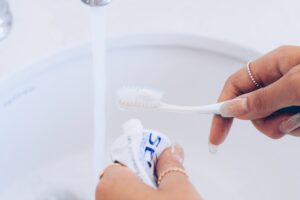Everyone wants a bright, white smile, but many people wonder if regular toothpaste or special whitening toothpaste can make a real difference. Yellow or stained teeth can be caused by a variety of factors, including food, drinks, and smoking, and many are eager to know if toothpaste alone can reverse the discoloration. This article will explore whether toothpaste can truly whiten teeth, how whitening toothpaste works, and the best way to achieve a whiter smile.
Can You Really Whiten Your Teeth with Toothpaste?
Yes, toothpaste can help whiten your teeth to some extent. However, it’s important to understand that regular toothpaste or even whitening toothpaste won’t dramatically change the color of your teeth overnight. Toothpaste that claims to whiten teeth usually contains mild abrasives or chemicals that help remove surface stains, which can make your teeth appear whiter.

That said, toothpaste is generally not powerful enough to change the natural color of your teeth or to remove deep stains. Most whitening toothpastes can only whiten teeth by removing surface stains caused by things like coffee, tea, or smoking. For more significant results, you might need professional whitening treatments or more advanced products like whitening strips.
How Does Whitening Toothpaste Work?
Whitening toothpaste works by using a few key ingredients to remove surface stains and polish your teeth. Most whitening toothpastes contain mild abrasives that scrub away stains on the surface of your teeth. These abrasives are usually safe for your enamel, though overusing them could cause wear over time.
Some whitening toothpastes also contain chemical agents like hydrogen peroxide or carbamide peroxide, which are common ingredients in professional teeth whitening products. However, the concentration of these agents in toothpaste is typically much lower than in products designed specifically for whitening, so the results are more subtle.
Ingredients in Whitening Toothpaste:
- Abrasives: Mild polishing agents that scrub surface stains off the enamel.
- Hydrogen peroxide: A chemical that helps bleach teeth, although it’s used in low concentrations in toothpaste.
- Blue Covarine: Some whitening toothpastes contain this blue pigment, which creates an optical illusion that makes teeth look whiter right after brushing.
Does Whitening Toothpaste Actually Work?
The effectiveness of whitening toothpaste varies depending on the type of stains you have and your expectations. For surface stains caused by food and drinks, whitening toothpaste can help gradually improve the brightness of your teeth. The mild abrasives in the toothpaste can remove stains that discolor the enamel, leading to a brighter appearance over time.

However, if you have deep or intrinsic stains, which are stains within the tooth itself, whitening toothpaste won’t be as effective. Deep stains are often caused by things like aging, certain medications, or trauma to the teeth. In these cases, professional whitening treatments from a dentist are usually required to achieve significant results.
Can Toothpaste Get Rid of Yellow Teeth?
Whitening toothpaste can help reduce the yellow appearance of your teeth if the yellowing is caused by surface stains. Many people experience yellow teeth due to things like drinking coffee, tea, or red wine, and smoking. Over time, these substances can leave behind a layer of stain on the enamel that makes teeth look yellow or discolored.
By removing this layer of stain, whitening toothpaste can make your teeth look whiter. However, if your teeth are yellow because of thinning enamel (which can happen as you age), or because of genetics, toothpaste might not make much of a difference. Thinning enamel can cause the dentin (the layer beneath the enamel) to show through, and dentin is naturally yellow.
In such cases, using toothpaste alone won’t be enough to change the color of your teeth, and you might need to explore other whitening options like bleaching treatments or veneers.
How Long Does it Take to Whiten Teeth with Toothpaste?
Whitening toothpaste can take several weeks to a few months to show noticeable results. It’s important to be patient and realistic about what whitening toothpaste can achieve. Most whitening toothpastes are designed to remove surface stains gradually, and the change won’t be dramatic right away.
Typically, if you use whitening toothpaste twice a day, you may start to see subtle results in about two to six weeks. However, the exact timing depends on the type and extent of the stains on your teeth. If you’re hoping for a brighter smile quickly, you might want to consider combining toothpaste with other whitening products like whitening strips or a whitening gel.
It’s also important to maintain consistent oral hygiene habits while using whitening toothpaste, as this will help maximize its effects.
Can Whitening Toothpaste Damage Your Teeth?
Whitening toothpaste is generally safe for most people, but it can have some downsides if overused. Most whitening toothpastes rely on abrasives to scrub away surface stains, and over time, these abrasives could cause enamel erosion if used too aggressively. Enamel is the hard, protective outer layer of your teeth, and once it’s worn down, it can’t be replaced.

If your enamel wears away, it can expose the dentin underneath, which is yellow in color and can make your teeth appear more yellow rather than whiter. That’s why it’s important to use whitening toothpaste as directed and to be mindful of how hard you brush your teeth.
If you have sensitive teeth or if you notice increased sensitivity while using whitening toothpaste, you may want to switch to a gentler product, like a sensitivity toothpaste that still offers mild whitening benefits.
What’s the Best Way to Whiten Teeth?
While whitening toothpaste can help brighten your smile, it’s just one piece of the puzzle. To get the best whitening results, you may need to combine toothpaste with other methods. Here are a few other common ways to whiten teeth:
Professional Whitening Treatments
If you’re looking for a dramatic improvement, professional whitening treatments from a dentist are the most effective option. Dentists use stronger whitening agents than over-the-counter products, which can lead to quicker and more noticeable results.
Whitening Strips and Gels
Over-the-counter whitening strips and gels are also popular options for whitening teeth. These products contain peroxide that can penetrate the enamel and whiten the tooth from the inside out. Results from whitening strips are usually more noticeable than toothpaste, and you can often see a difference in just a few days.
Whitening Trays
Another at-home option is whitening trays, which are filled with a whitening gel and worn over the teeth for a set period of time. These trays can be purchased over the counter or custom-made by a dentist for a more precise fit. Whitening trays work in a similar way to whitening strips by using peroxide to bleach the teeth.
Preventing Stains
The best way to maintain a white smile is to prevent stains from building up in the first place. Brushing and flossing regularly, drinking water after consuming staining foods or beverages, and avoiding tobacco products can all help prevent stains from forming.
Does Toothpaste Prevent Future Stains?
One of the benefits of using whitening toothpaste is that it can help prevent new stains from forming. Many whitening toothpastes contain ingredients that create a protective barrier on your teeth, making it harder for new stains to stick.

Toothpaste that contains fluoride also strengthens enamel, which helps protect against stains and decay. Fluoride doesn’t whiten teeth directly, but it does make your teeth more resistant to the acids produced by bacteria, which can cause discoloration over time.
How to Keep Teeth White After Using Whitening Toothpaste:
- Brush regularly with a whitening toothpaste to remove surface stains.
- Avoid foods and drinks that are known to cause staining, such as coffee, tea, and red wine.
- Rinse your mouth with water after eating or drinking staining substances.
- Visit your dentist regularly for professional cleanings, which can remove deeper stains that toothpaste can’t.
Conclusion: Can Toothpaste Whiten Teeth?
In short, yes, toothpaste can help whiten teeth—but it has its limitations. Whitening toothpaste is effective at removing surface stains and making your teeth look brighter over time. However, it’s not a magic solution for deep stains or for dramatically changing the color of your teeth.
For the best results, combine whitening toothpaste with other whitening products or treatments, and focus on maintaining good oral hygiene to prevent stains from forming in the first place. If you have serious concerns about the color of your teeth, it’s always a good idea to talk to your dentist about professional whitening options.
With patience and consistency, whitening toothpaste can be a helpful tool in achieving and maintaining a bright, healthy smile!

